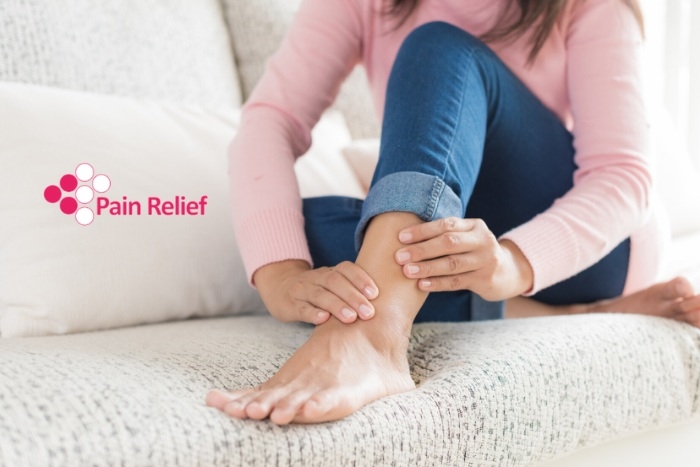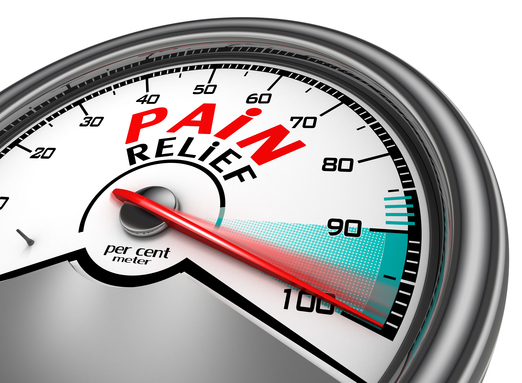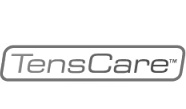You have no items in your shopping cart.
Low Level Laser Therapy Treatment: How it Helps Pain-Related Disorders including Fibromyalgia

Advancements in low-level laser therapy (LLLT) trials reveal that pain conditions, such as fibromyalgia, osteoporosis, and arthritis can be successfully treated with LLLT. Studies suggest that LLLT treats many conditions with no side effects or risk factors.
By harnessing the power of LLLT in one simple device, Handy Cure brings effective pain relief to your home. Learn about this pain-relieving revolution below.
What is LLLT and how can it help my practice?
Though it has been used widely in Europe and Asia for decades, low-level laser therapy (LLLT) was only recently introduced to the Western world. Known alternately as low-power laser, soft laser, cold laser, biostimulation laser, therapeutic laser, and laser acupuncture, LLLT is used primarily as a means of stimulating circulation and cells growth in a wide range of therapeutic applications.
Handy Cure's Therapeutic Laser harnesses the healing power of low-level pulsed infrared lasers, visible red light, and static magnetic fields in a portable hand-held device that is equally suitable for home and office use. Most LLLT devices emit no heat, sound, or vibration. The Handy Cure is versatile, user-friendly, and cost-effective, boasting a 25,000-hour lifespan that can be used to treat a wide range of ailments and disorders. This non-invasive light source treatment generates a single wavelength of light that can be used to target specific areas of the body.
The non-invasive, and safe application of LLLT makes the possibilities for practice implementation nearly limitless. The Handy Cure is an affordable treatment modality with an extensive lifespan. As the demand for LLLT continues to grow, practitioners would be remiss to omit this affordable treatment modality from their arsenal.
Use of LLLT is recommended in conjunction with other therapeutic modalities.
How does the Handy Cure work?
The Handy Cure combines the power of LLLT and magnetic field therapy.
Though the exact healing mechanism remains unclear, LLLT has been shown to react with the respiratory enzyme cytochrome c oxidase, which is involved in the electronic transport chain in mitochondria (Chung et al, 2012). By emitting laser light through low-level laser diode, 4 infrared LEDs, and 4 red LEDs, the Handy Cure delivers speedy synergistic therapeutic results. Patients around the world have responded favorably to the pain relief and healing effects of LLLT, and a growing body of empirical research supports these findings.
Currently, there are over 5,000 peer-reviewed clinical research articles in the scientific literature supporting the use of LLLT. This research spans many medical specialties including orthopedics, neurology, rheumatology, dermatology, cardiology, dentistry, and more.
Magnetic field therapy has applications in the management of painful musculoskeletal problems due to its rehabilitative, regenerative, analgesic, and relaxing effects. Magnetic field therapy is often integrated into treatment plans targeting arthritic disorders, myofascial pain, tendinopathy, and inflammation.
Summary and overview of the Handy Cure's benefits and features:
· Harnesses the power of 3 different light wavelengths for customizable care: 905nm, 875 nm, and 635nm
· Integrates the benefits of static magnetic fields
· Relieves acute and chronic pain in a variety of conditions
· Improves micro-circulation
· Reduces inflammation
· Non-invasive, non-toxic, and pain-free treatment with no side effects
· Can reduce client dependence on analgesics and anti-inflammatory drugs
· Compact and portable for mobile therapeutic treatments
· Effective as both a standalone or supplementary treatment used in conjunction with physiotherapy, chiropractic treatments, massage, hydrotherapy, medication, and more
· Rechargeable integral lithium battery for economic and Eco-friendly use
· Safe and user-friendly; ideal for home-use
· 2-year warranty
· Class 1M laser
· Class 2a Medical Device
· Lifespan of 25,000+ hours, certified by manufacturer
What are the medical and rehabilitative applications for LLLT?
The Handy Cure can be integrated into dental health, physiotherapy, chiropractic treatments, hydrotherapy, rehabilitation, massage therapy, and more. Read on for empirical information about the Handy cure's musculoskeletal, oral health, and hair treatment applications.
Fibromyalgia
Often misdiagnosed as Arthritis, its common characteristics include widespread pain in muscles and joints, fatigue, anxiety, depression, and a decreased pain threshold. Fibromyalgia can cause you to feel pain all over your body. You might find that some parts of your body are tender or even too painful to touch.
More Musculoskeletal Applications
Chow et al (2009) concluded that LLLT can ameliorate both acute and chronic neck pain. A literature review was conducted on 16 randomized, controlled trials that involved over 800 patients with neck pain that was not sourced to specific causes. Researchers concluded that LLLT was an effective means of reducing acute pain and providing mid-term relief of chronic aches.
An estimated 80% of people will experience back pain at some point in their lives. A review conducted by Huang et al (2015) determined that LLLT could benefit sufferers of chronic low-back pain by stimulating cell growth and circulation. These findings were supported by research by Djavid et al (2007), who concluded that a combination of exercise and LLLT was more effective for managing lower back pain than exercise alone.
The Handy Cure has also been proven effective as a short-term treatment for pain caused by rheumatoid arthritis, osteoarthritis, and chronic joint disorders (Bjordal et al, 2003; Brosseau et al, 2005). A single application of LLLT was shown to produce significant reductions in inflammatory cell infiltration and inflammatory cytokines. LLLT has also been shown to mitigate the effects of compromised micro-circulation, and improve oxygenation of cells and tissues. By improving circulation and blood flow, LLLT shortens the duration of ischaemic episodes and minimizes associated pain and discomfort.
Researchers have begun to explore the benefits of LLLT for tendinopathy. Haslerud et al (2015) found it to be an effective modality in a complete shoulder tendinopathy program, able to produce greater results than programs that omitted LLLT. Page et al (2014) noted its efficacy in improving circulation, mobility, and pain levels in patients with “frozen shoulder.”
Teeth and Oral Infections
Dental professionals around the world are starting to understand and appreciate the oral health applications of LLLT. Cobb (2006) found that LLLT devices like the Handy Cure produced exceptional results in the treatment of chronic periodontitis. Similarly, Sculean et al (2005) noted LLLT's ability so speed the healing of infections around dental implants. Evidence is now being released indicating LLLT's potential use as a treatment for dentin hypersensitivity, wisdom tooth extraction complications, and oral mucositis (He et al, 2015; Oberoi et al, 2014; Sgolastra et al, 2013).
Hair Loss Prevention
LLLT is an exciting new treatment option for hair loss. Though practitioners in Europe have praised this method for years, the FDA only recently approved LLLT as a treatment for androgenetic alopecia, known colloquially as male-pattern baldness. Laser light travels into the tissue of the scalp, stimulating the production of energy at the cellular level, improving cell function and potentially triggering new hair growth. Some patients will respond better than others, but LLLT's non-chemical, non-invasive, and side-effect free characteristics means anyone can experiment with this option.
Other Treatment Applications
The non-invasive, side-effect free nature of LLLT means that it can be integrated into almost any treatment program. The possibilities for your practice are endless.
Studies have suggested LLLT as an effective option to treat pain and swelling in breast-cancer related lymphedema (Smoot et al, 2015). LLLT has also been used successfully to speed wound healing and deliver acute pain relief for a wide variety of injuries and conditions.
For further references and treatment applications, please go to http://www.pubmed.gov and search “Low-Level Laser Therapy.”
Can patients cover LLLT treatment costs using their insurance?
Because it is a new modality in the Western world, insurance companies have classified LLLT as an “experimental treatment,” which means that most coverage will not include this form of therapy. However, this will likely change within the next 5 years as researchers continue to publish empirical evidence of its efficacy in treating a wide range of acute and chronic conditions.
The Handy Cure's Technical Specifications
Average power:
· Total radiation: 60-90 mW
· Laser radiation: 0.4-6.25 mW
· Infrared radiation: 30-40 mW
· Red LEDs radiation: 2-10 mW
Permanent magnet induction:
· 25-45 mT
Wavelengths:
· Infrared laser radiation: 905 nm (invisible radiation)
· Infrared LED radiation: 875 nm (invisible radiation)
· Red LED radiation: 635 nm (visible radiation)
Laser power:
· 25 W
Maximum pulsating laser power:
· 25 W
Equipment type:
· Class 2 equipment, Applied Part Type
· Laser Class 1 (IEC 60825-1)
Power Input
· 100-240 V ~ 50/60 Hz
Power Output:
· 13 V
Supply ratings:
· 13 VDC, max. 1.3A
Lifespan:
· 25,000 hours of effective use
Authors
Brandon Rea and Dr. Joshua Sinberg
Brandon Rea studied English and English Literature, receiving a Bachelor's Degree from York University in 2012. He is currently working as a writer and editor. He is passionate about finding new ways to engage his audience, and influence conversations.
Dr. Sinberg received his Doctor of Chiropractic degree from Parker University in Dallas, TX in 1997. He has extensive training in anatomy, biomechanics, many forms of chiropractic manual therapies of the spine and extremities, rehabilitation, radiology, chiropractic pediatrics, soft-tissue treatment, and more. As well as his chiropractic work, Dr. Sinberg has also worked in the medical device industry for 7 years as a manager and technical consultant to surgeons in the operating room
References
Bjordal, JM; Couppé, C; Chow, RT; Tunér, J; Ljunggren, EA (2003). "A systematic review of low level laser therapy with location-specific doses for pain from chronic joint disorders". The Australian journal of physiotherapy. 49(2): 107–16.
Brosseau, L.; Welch, V.; Wells, G. A.; de Bie, R.; Gam, A.; Harman, K.; Morin, M.; Shea, B.; Tugwell, P. (2005). "Low level laser therapy (Classes I, II and III) for treating rheumatoid arthritis". Cochrane Database of Systematic Reviews (4): CD002049.
Chow, R.; Johnson, M.; Lopes-Martins, R.; Bjordal, J. (Nov 2009). "Efficacy of low-level laser therapy in the management of neck pain: a systematic review and meta-analysis of randomised placebo or active-treatment controlled trials." Lancet. 374 (9705): 1897–1908.
Chung, Hoon; Dai, Tianhong; Sharma, Sulbha K.; Huang, Ying-Ying; Carroll, James D.; Hamblin, Michael R. (2012-02-01). "The nuts and bolts of low-level laser (light)therapy". Annals of Biomedical Engineering. 40 (2): 516–533.
Cobb, C. M. (2006). "Lasers in Periodontics: A Review of the Literature". Journal of Periodontology. 77 (4): 545–564.
Djavid, G.,k Mehrdad, R., Ghasemi, M, Hasan-Zadeh, H., Sotoodeh-Manesh, A., & Pourvaghoub, G. (2007). In chronic low back pain, low level laser therapy combined with exercise is more beneficial than exercise alone in the long term: A randomised trial. Aust J Physiother, 53(4): 216.
Haslerud, Sturla; Magnussen, Liv Heide; Joensen, Jon; Lopes-Martins, Rodrigo Alvaro Brandao; Bjordal, Jan Magnus (2015-06-01). "The efficacy of low-level laser therapy for shoulder tendinopathy: a systematic review and meta-analysis of randomized controlled trials". Physiotherapy Research International: The Journal for Researchers and Clinicians in Physical Therapy. 20 (2): 108–125.
He, W. L.; Yu, F. Y.; Li, C. J.; Pan, J.; Zhuang, R.; Duan, P. J. (2015-08-01). "A systematic review and meta-analysis on the efficacy of low-level laser therapy in the management of complication after mandibular third molar surgery". Lasers in Medical Science. 30 (6): 1779–1788.
Huang, ZeYu; Ma, Jun; Chen, Jing; Shen, Bin; Pei, FuXing; Kraus, Virginia Byers (2015-01-01). "The effectiveness of low-level laser therapy for nonspecific chronic low back pain: a systematic review and meta-analysis". Arthritis Research & Therapy. 17: 360
Oberoi, Sapna; Zamperlini-Netto, Gabriele; Beyene, Joseph; Treister, Nathaniel S.; Sung, Lillian (2014-01-01). "Effect of prophylactic low level laser therapy on oral mucositis: a systematic review and meta-analysis". PLOS ONE. 9 (9): e107418.
Page, MJ; Green, S; Kramer, S; Johnston, RV; McBain, B; Buchbinder, R (Oct 1, 2014). "Electrotherapy modalities for adhesive capsulitis (frozen shoulder).". The Cochrane database of systematic reviews. 10: CD011324.
Sculean, A.; Schwarz, F.; Becker, J. (2005). "Anti-infective therapy with an Er:YAG laser: influence on peri-implant healing".Expert Review of Medical Devices. 2 (3): 267–76.
Sgolastra, F.; Petrucci, A.; Severino, M.; Gatto, R.; Monaco, A. (2013-06-01). "Lasers for the treatment of dentin hypersensitivity: a meta-analysis". Journal of Dental Research. 92 (6): 492–499.
Smoot, Betty; Chiavola-Larson, Laura; Lee, Jeannette; Manibusan, Hidelisa; Allen, Diane D. (2015-06-01). "Effect of low-level laser therapy on pain and swelling in women with breast cancer-related lymphedema: a systematic review and meta-analysis". Journal of Cancer Survivorship: Research and Practice. 9(2): 287–304.


















































































































































 Default Store View
Default Store View  New Theme
New Theme